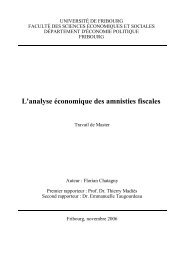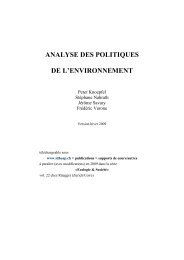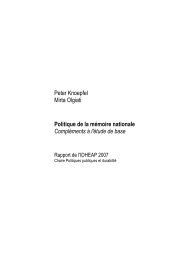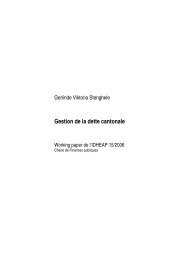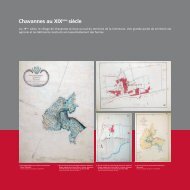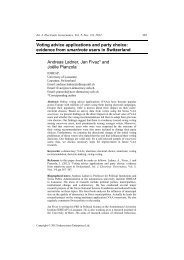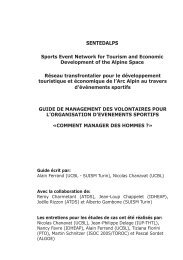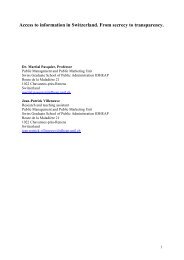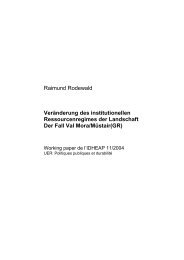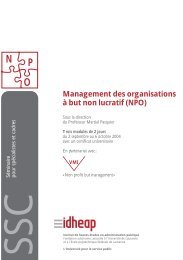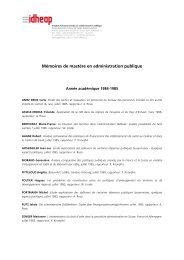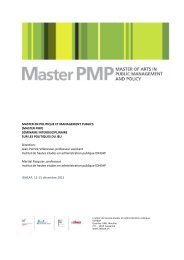Historical Analysis of Institutional Regimes in Switzerland ... - IDHEAP
Historical Analysis of Institutional Regimes in Switzerland ... - IDHEAP
Historical Analysis of Institutional Regimes in Switzerland ... - IDHEAP
Create successful ePaper yourself
Turn your PDF publications into a flip-book with our unique Google optimized e-Paper software.
1<br />
1 Introduction<br />
Any number <strong>of</strong> examples can be provided to demonstrate the ongo<strong>in</strong>g degradation <strong>of</strong> natural<br />
resources. The use <strong>of</strong> such threatened resources can be <strong>in</strong>stitutionally <strong>in</strong>fluenced and managed with<br />
the help <strong>of</strong> <strong>Institutional</strong> Resource <strong>Regimes</strong> (IR). As we understand it, an IR is a comb<strong>in</strong>ation <strong>of</strong><br />
factors such as formal property and use rights (= regulative system) and the prom<strong>in</strong>ent programme<br />
elements <strong>of</strong> resource-specific protection and/or use policies (= policy design), whose policy design<br />
comprises specific aims with respect to protection and use, <strong>in</strong>tervention <strong>in</strong>struments, actor<br />
arrangements etc. The central postulate <strong>of</strong> this new approach assumes that the two steer<strong>in</strong>g<br />
dimensions are complementary and must be considered to achieve susta<strong>in</strong>able resource management.<br />
The start<strong>in</strong>g po<strong>in</strong>t <strong>of</strong> our reflection is the question as to how <strong>in</strong>stitutions affect <strong>in</strong>dividual behaviour<br />
and resource management. The proposed paper exam<strong>in</strong>es if and how IRs adjust to changes <strong>in</strong> the<br />
structures <strong>of</strong> users as well as to the <strong>in</strong>creased use and scarcity <strong>of</strong> resources. By compar<strong>in</strong>g the<br />
historical development <strong>of</strong> IRs for five resources (forest, water, land, clean air and landscape) <strong>in</strong><br />
<strong>Switzerland</strong>, we ga<strong>in</strong> <strong>in</strong>itial <strong>in</strong>sights <strong>in</strong>to the triggers <strong>of</strong> IR emergence and change. To be able to<br />
analyse the development <strong>of</strong> the different IRs, it is first necessary to def<strong>in</strong>e what is meant by a natural<br />
resource (Chapter 2) and the resource management deficits identified by traditional economic and<br />
political-scientific approaches (Chapter 3). On this basis, we identify the different constitutive<br />
elements <strong>of</strong> an <strong>Institutional</strong> Resource Regime (IR) and propose an <strong>in</strong>itial typology <strong>of</strong> IRs and an<br />
ideal-typical presentation <strong>of</strong> various development trajectories (Chapter 4). These new theoretical<br />
concepts (basic elements, IR typology and development trajectory) are then explored on the basis <strong>of</strong><br />
five resources (Chapter 5). In the f<strong>in</strong>al chapter (Chapter 6), we discuss the theoretical and practical<br />
usefulness <strong>of</strong> the proposed IR approach.<br />
2 Resource def<strong>in</strong>ition and resource degradation<br />
We def<strong>in</strong>e natural resources as natural and man-made components <strong>of</strong> nature that are important to<br />
people 1 (Wiesmann 1995: 13; Siebert 1983: 2). Socio-economic and socio-cultural factors play a<br />
key role <strong>in</strong> what is and is not def<strong>in</strong>ed as a natural resource (O'Riordan 1971; Grima and Berkes,<br />
1989: 33). The historical po<strong>in</strong>t <strong>in</strong> time and spatial reference (local, global) are also important here. A<br />
dist<strong>in</strong>ction is made between the resource stock and its fruit/susta<strong>in</strong>ed yield. When we refer to a<br />
natural resource, we <strong>in</strong>tend both its stock and its susta<strong>in</strong>ed yield (Ostrom 1990: 30f.).<br />
The time taken for renewal provides <strong>in</strong>formation about whether it is a renewable or non-renewable<br />
resource. Depend<strong>in</strong>g on the exist<strong>in</strong>g resource stock, renewable resources can renew themselves<br />
with<strong>in</strong> decision-mak<strong>in</strong>g periods that are relevant to humans without targeted human <strong>in</strong>tervention<br />
(Endres/Querner 1993: 3).<br />
Resources provide different goods and services. Resources give rise to either direct use (e.g. as <strong>in</strong>put<br />
factors <strong>in</strong> production processes or the direct consumption option), <strong>in</strong>direct use (e.g. adsorption s<strong>in</strong>k<br />
for pollutants, ecosystem services) or immaterial use (e.g. <strong>in</strong> the form <strong>of</strong> landscape,<br />
“amenity/aesthetic/cultural values”) by people (Young 1992:8-10; Perman et al. 1998).<br />
1<br />
The Internet is an example <strong>of</strong> a non-natural resource.



